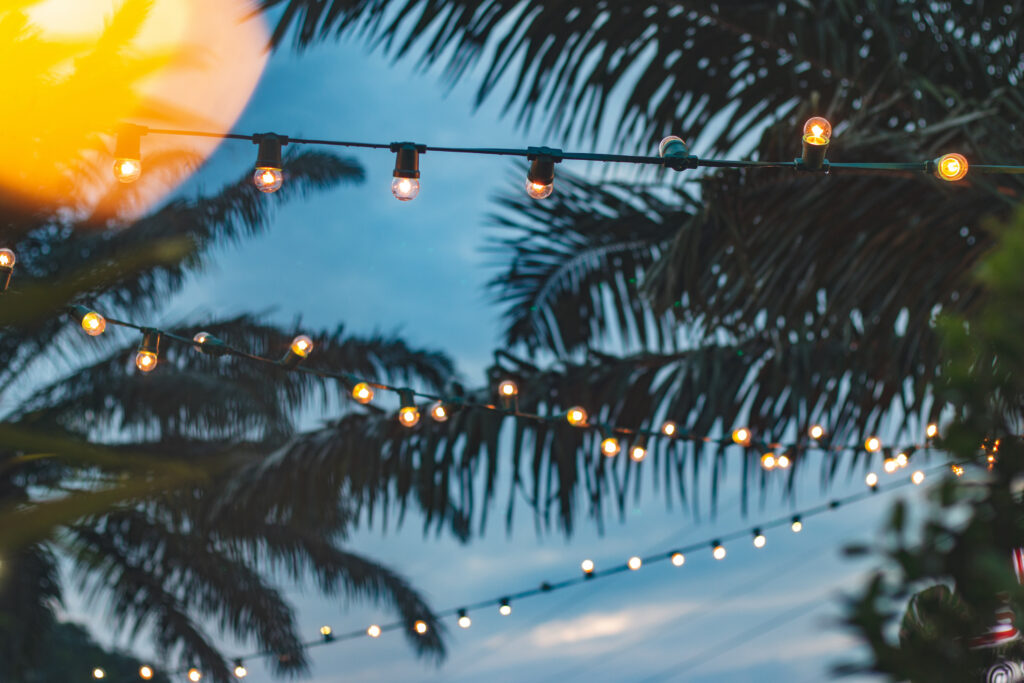String lights, or ‘fairy lights’, make for an attractive decoration in any environment, but can you put them on plants?
If the string lights in question are low-energy and do not give off too much heat, then they’re absolutely fine to be put on plants. However, if larger, hotter bulbs are featured on the string lights, then they present a fire hazard, or at the least, will stunt the growth of the plant.

Read on to learn more about string lights, where they came from, and the many different uses they have today.
Invent One, And The Rest Will Follow
Today, we all know Thomas Edison as the inventor of the incandescent lightbulb. It was a revolutionary and remarkable invention that quite literally changed the face of the Earth, introducing light where none previously existed.
It was in 1879, in a laboratory in New Jersey, that Thomas Edison successfully constructed the first incandescent light, powered with electricity. As you might imagine, it wasn’t a perfect first attempt, and the filament in the bulb melted in just a few hours.
Reportedly, Edison tested thousands of different metals and other materials inside of his new-fangled lightbulb. His key goal was to find a material that could withstand the immense heat generated by the electricity coursing along the filament.
It’s also said that Edison attempted to work with tungsten, the metal that lightbulb filaments are constructed from today. However, owing to limitations with tooling and implements, he was unable to gain any traction and abandoned the metal.
At one point, Edison considered using ‘carbonized’ natural materials such as bamboo and plant fibers. Finally, and bizarrely, Edison settled on a carbonized cotton filament – a literal thread of cotton that contained the electricity better than any metal he’d tested.
This was in 1880, and by 1882, Thomas Edison had created a string of electrical lights – quite literally, string lights. He began something of a tradition, hanging the lights outside his laboratory in New Jersey around Christmas time.
And then, as the twentieth century arrived, so too did enhanced innovation, and before long, the string light would receive some massive upgrades.
Lighting Up The World
These days, string lights are diverse, beautiful, and have many different uses. They can be incandescent bulbs, LED lamps, or some other, wondrous creation, all designed to brighten up a space and make it look infinitely more attractive.
Thomas Edison’s lights, while legendary and unforgettable, are a thing of the past, and in their place sits a rainbow spectrum of twinkling LED starlights. Today, you can find globe lights, mini lanterns, rope lights, and what we lovingly refer to as just ‘Christmas lights’.
They’re seen in almost every culture around the world, in one way or another. They’re used to celebrate weddings, birthdays, or to brighten up a party – or any other kind of celebration, through the power of light.
When Christmas rolls around, they’re hung in their millions, or potentially even billions, as people dress their homes and their trees in attractive lights. It’s a tradition – a staple of Christmas that goes hand-in-hand with gifts, bearded red-dressed men, and carols.
But, as we mention trees, we come to the question of the hour: can you put string lights on trees?
Dressing Foliage
There’s absolutely no issue with hanging string lights on plants, as long as you’re doing it correctly.
For example, if you’re using a string of powerful, vintage incandescent bulbs, they’ll throw off a lot of heat. When this is your practice, you’re running the risk of causing a fire, and you’ll almost certainly kill, shrivel, or stunt the growth of the plant itself.
If you’re putting string lights on a plant and keeping them permanently illuminated, you’ll certainly confuse the plant. There’s plenty of harm that can be caused by excessive light, and you can interrupt the plant’s day/night rhythm by permanently lighting it up.
But, if you’re using low-energy, LED lights that emit very little heat, there are no concerns whatsoever, and you can hang them on almost any plant. In fact, there are some string lights of this type made specifically to be hung outdoors, on plants.
If there was a major concern with hanging string lights on plants, people wouldn’t illuminate entire trees with them once a year, every year. It’s like most things – if you’re doing it right, there is nothing to worry about, and the end result will look quite beautiful.
